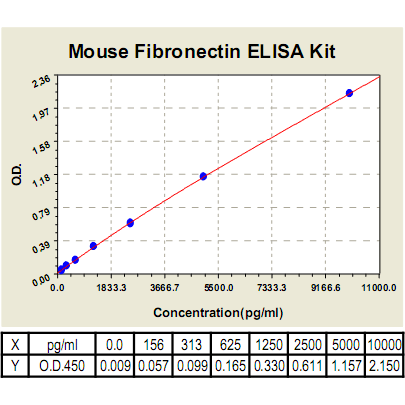Product Sheet CL0351
Description
BACKGROUND Fibronectin (FN) is a high molecular weight glycoprotein present in a soluble dimeric form in plasma, and in a dimeric or multimeric form at the cell surface and in extracellular matrix. FN is widely expressed by multiple cell types and is critically important in vertebrate development, as demonstrated by the early embryonic lethality of mice with targeted inactivation of the FN gene. Fibronectin (FN) mediates a wide variety of cellular interactions with the extracellular matrix (ECM) and plays important roles in cell adhesion, migration, growth and differentiation processes including embryogenesis, wound healing, blood coagulation, host defense, and metastasis.1
FN usually exists as a dimer composed of two nearly identical 250 kDa subunits linked covalently near their C-termini by a pair of disulfide bonds (see poster). Each monomer consists of three types of repeating units (termed FN repeats): type I (purple rectangles), type II (green octagons) and type III (red ovals). FN contains 12 type I repeats, two type II repeats and 15-17 type III repeats, which together account for approximately 90% of the FN sequence. Although FN molecules are the product of a single gene, the resulting protein can exist in multiple forms that arise from alternative splicing of a single pre-mRNA that can generate as many as 20 variants in human FN. FN can be a ligand for a dozen members of the integrin receptor family. In addition, FN has a remarkably wide variety of functional activities besides binding to cell surfaces through integrins. It binds to a number of biologically important molecules that include heparin, collagen/gelatin, and fibrin. These interactions are mediated by several distinct structural and functional domains.2 Anastellin binds fibronectin and induces fibril formation. This fibronectin polymer, named superfibronectin, exhibits enhanced adhesive properties. Both anastellin and superfibronectin inhibit tumor growth, angiogenesis and metastasis. Anastellin activates p38 MAPK and inhibits lysophospholipid signaling.3
FN usually exists as a dimer composed of two nearly identical 250 kDa subunits linked covalently near their C-termini by a pair of disulfide bonds (see poster). Each monomer consists of three types of repeating units (termed FN repeats): type I (purple rectangles), type II (green octagons) and type III (red ovals). FN contains 12 type I repeats, two type II repeats and 15-17 type III repeats, which together account for approximately 90% of the FN sequence. Although FN molecules are the product of a single gene, the resulting protein can exist in multiple forms that arise from alternative splicing of a single pre-mRNA that can generate as many as 20 variants in human FN. FN can be a ligand for a dozen members of the integrin receptor family. In addition, FN has a remarkably wide variety of functional activities besides binding to cell surfaces through integrins. It binds to a number of biologically important molecules that include heparin, collagen/gelatin, and fibrin. These interactions are mediated by several distinct structural and functional domains.2 Anastellin binds fibronectin and induces fibril formation. This fibronectin polymer, named superfibronectin, exhibits enhanced adhesive properties. Both anastellin and superfibronectin inhibit tumor growth, angiogenesis and metastasis. Anastellin activates p38 MAPK and inhibits lysophospholipid signaling.3
REFERENCES
1. Hynes, R.O. & Yamada, K.M.: J Cell Biol. 95:369-77, 1982
2. Pankov, R. & Yamada, K.M.: J. Cell Sci. 115:3861-3, 2002
3. Morla, A. et al: Nature367:193-6, 1997
2. Pankov, R. & Yamada, K.M.: J. Cell Sci. 115:3861-3, 2002
3. Morla, A. et al: Nature367:193-6, 1997
Products are for research use only. They are not intended for human, animal, or diagnostic applications.
Details
Cat.No.: | CL0351 |
Target Protein Species: | Mouse |
Range: | 125pg/ml-10,000pg/m |
Specificity: | No detectable cross-reactivity with any other cytokine. |
Storage: | Store at 4°C. Use within 6 months. |
ELISA Kits are based on standard sandwich enzyme-linked immunosorbent assay technology. Freshly prepared standards, samples, and solutions are recommended for best results.
Products
| Product | Size | CAT.# | Price | Quantity |
|---|---|---|---|---|
| Mouse Fibronectin ELISA Kit: Mouse Fibronectin ELISA Kit | Size: 96 Wells | CAT.#: CL0351 | Price: $533.00 |

